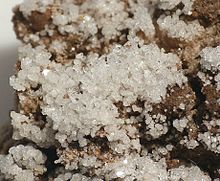| Salammoniac | |
|---|---|
 | |
| General | |
| Category | Halide mineral |
| Formula (repeating unit) | NH4Cl |
| IMA symbol | Sam[1] |
| Strunz classification | 3.AA.25 |
| Crystal system | Isometric |
| Crystal class | Hexoctahedral (m3m) H-M symbol: (4/m 3 2/m) |
| Space group | Pm3m |
| Unit cell | a = 3.859 Å; Z = 1 |
| Identification | |
| Formula mass | 53.49 g/mol |
| Color | Colorless, white, pale gray; may be pale yellow to brown, if impure. |
| Crystal habit | Crystals skeletal or dendritic; massive, encrustations |
| Twinning | On {111} |
| Cleavage | Imperfect on {111} |
| Fracture | Conchoidal |
| Tenacity | Sectile |
| Mohs scale hardness | 1–2 |
| Luster | Vitreous |
| Streak | White |
| Diaphaneity | Transparent |
| Specific gravity | 1.535 |
| Optical properties | Isotropic |
| Refractive index | n = 1.639 |
| Birefringence | Weak after deformation |
| Ultraviolet fluorescence | No |
| Absorption spectra | No |
| Solubility | In water |
| References | [2][3][4] |

Salammoniac,[2] also sal ammoniac or salmiac, is a rare naturally occurring mineral composed of ammonium chloride, NH4Cl. It forms colorless, white, or yellow-brown crystals in the isometric-hexoctahedral class. It has very poor cleavage and is brittle to conchoidal fracture. It is quite soft, with a Mohs hardness of 1.5 to 2, and it has a low specific gravity of 1.5. It is water-soluble. Salammoniac is also the archaic name for the chemical compound ammonium chloride.
- ^ Warr, L.N. (2021). "IMA–CNMNC approved mineral symbols". Mineralogical Magazine. 85 (3): 291–320. Bibcode:2021MinM...85..291W. doi:10.1180/mgm.2021.43. S2CID 235729616.
- ^ a b "Salammoniac". mindat.org and the Hudson Institute of Mineralogy.
- ^ "Redirect for Sal-ammoniac". webmineral.com.
- ^ "Handbook of Mineralogy" (PDF).